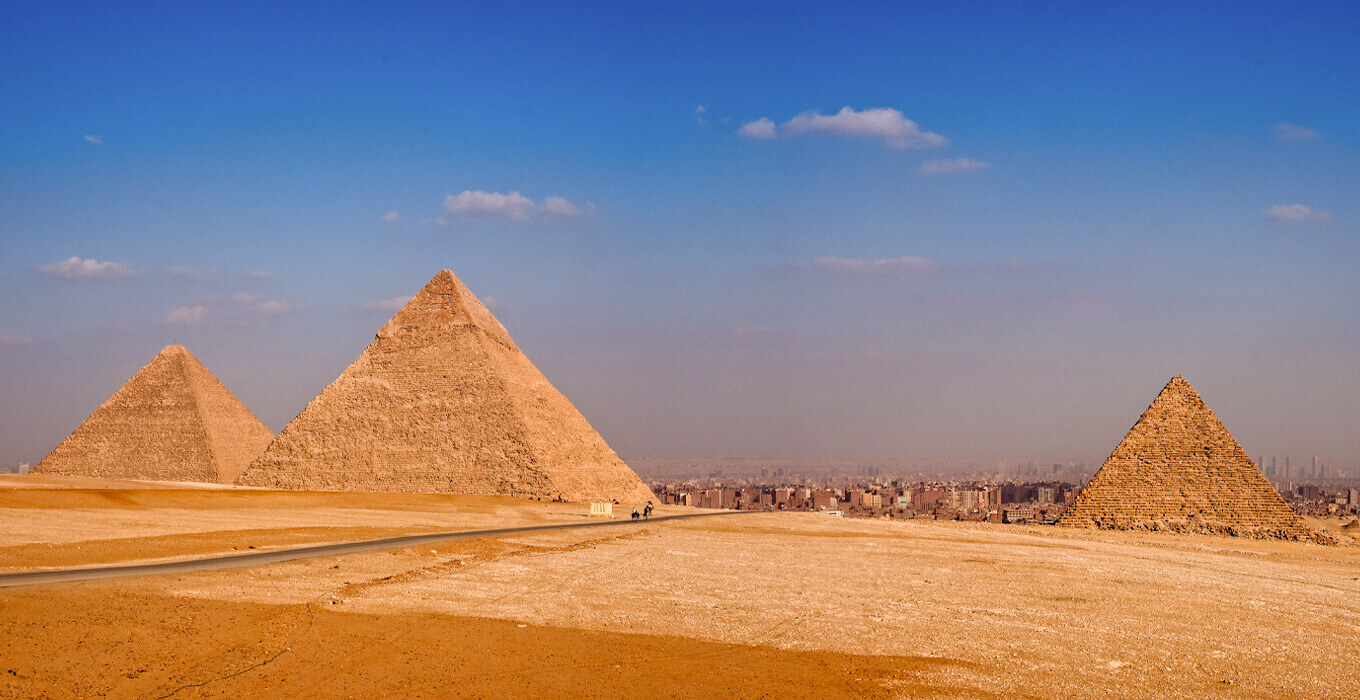The Egyptian pyramids have always sparked wonder and debate. How did they build these huge structures so long ago? Many theories try to explain How the Pyramids Were Built. These include ramp systems and even aliens. But which theory is right, and what proof do we have?
Let’s explore the pyramid construction theories. We’ll look into the secrets that have amazed people for centuries.
Key Takeaways
- The Construction of the Egyptian pyramids has been a subject of intense fascination and debate for centuries.
- Numerous theories have been proposed to explain how these massive structures were built, ranging from ramp systems to extraterrestrial involvement.
- The most accepted theory is the Ramp Theory, which suggests using massive ramps to move and place the heavy stone blocks.
- Other popular explanations include the Water Shaft Theory and the Limestone Concrete Theory, each offering unique perspectives on construction methods.
- Advances in archaeological research and analysis continue to shed new light on the construction techniques and workforce organization behind the pyramids.
Take advantage of our discounted offers with the following All-Inclusive Vacations to Egypt:
- 7-Day Cairo with Nile Cruise Tour Package Get -100 USD
- 8 Days Cairo with 3 Nights Nile Cruise by Flight Get 10% Off + Free Activities
- 8 Days Cairo and Nile Cruise Holidays with Abu Simbel Get 7% OFF
- 10-Day Cairo, Alexandria, and Nile Cruise with Abu Simbel by Flight Get 10% OFF
- 12-Day Cairo City & Nile Cruise and Hurghada City
How the Pyramids Were Built
The construction of the Egyptian pyramids has amazed people for centuries. The exact methods used are still debated. But, most think ramps were a key part of building them.

The Most Accepted Theory
The ramp theory says the ancient Egyptians built long ramps from mudbrick or limestone. These ramps helped move huge stone blocks to the top. They could be straight or spiral, letting workers slowly place the stones.
Recent finds near the pyramids support this idea. They show ramps were a big part of building the pyramids.
Two Popular Explanations
Two other ideas explain how the pyramids were built. The counterweight system theory says Egyptians used levers and pulleys to lift stones. The waterways and lubrication theory suggests they used water to make moving stones easier.
Building the pyramids was a huge achievement. It shows the ancient Egyptians’ skills and knowledge. Researchers keep finding new evidence and theories, helping us learn more about these amazing structures.
The Workforce Behind the Pyramids
Many think the pyramids were built by slaves, but research shows they were made by a skilled workforce. Tens of thousands of workers, not slaves, worked on the pyramids. They were skilled laborers.
Skilled Workers, Not Slaves
Herodotus thought the Great Pyramid took over 100,000 slaves to build. But this is now seen as wrong. Mark Lehner’s work says about 2,000 workers were on-site at a time. This means around 30,000 people worked on the pyramids.
Highly Organized Labor
The workers were divided into groups and smaller teams of about 200 men. They were well-fed and paid, either with bread or beer. The workforce changed often to handle the huge task of building the pyramids.
Studies show there were not as many slaves as people think in pyramid construction. Archaeologists are learning more about how the Aztecs and Mayans built their pyramids.
| Researcher | Estimated Workforce Size |
| Herodotus | Over 100,000 slaves |
| Mark Lehner and Zahi Hawass | 20,000 to 30,000 laborers |
| Conservative Estimate | 5,000 or fewer men |
“It was revealed that 12 men in bare feet could quarry 186 stones in 21 days, indicating the efficiency of ancient workers.”
Location: Strategic Placement of the Pyramids
The ancient Egyptians placed their pyramids on the west side of the Nile River. They chose this spot to avoid floods. This spot was perfect for keeping the pyramids stable and easy to reach.
The pyramids were near the capital, making it simple to get resources and workers. This was a big help in building them.
The Nile River was key to the pyramids’ location. It offered water, ways to move things, and other important resources. The pyramids sat on solid rock, which was strong enough to hold their huge size.
Building on high ground helped the Egyptians avoid the Nile’s floods. This was smart thinking that showed they knew their land well. They planned to deal with the floods.
The pyramids’ spot was thought out well. They considered being close to the capital, having access to what they needed, and the environment. This smart planning helped make the pyramids last so long.
“The location of the pyramids was a strategic decision that showcased the ancient Egyptians’ advanced planning and adaptability.”

The Base: Laying the Foundation
The ancient Egyptian pyramids needed a strong base. Builders used smart methods to make it happen. These methods showed their great engineering skills.
Quarrying Limestone and Granite
Limestone was the main material for the pyramids. It was easy to find in the area. For the outside, they used a special limestone from near Cairo to make it look smooth.
Granite came from Aswan for the roofs and chambers. This made the pyramids strong and beautiful.
Leveling the Base
First, the builders made the base level and strong. They removed sand and made it flat. Then, they built mud walls around it.
They cut channels for water and filled them. The water level showed where to make it even. After draining the water, they filled in any dips with stones.
This careful work was key. It helped avoid problems like the Meidum pyramid’s collapse. The Giza pyramids, especially Khufu’s, were built with amazing precision. Their base was almost perfectly level.
The hard work on the pyramid base and choosing local materials helped build these lasting wonders.
Don’t Miss To Read Our Atrical Top Restaurants Near Giza Pyramids
Architectural Precision of the Pyramids
The ancient Egyptians were experts in precision engineering. Their work on the pyramids shows their amazing pyramid architecture and pyramid architectural precision.
Astronomical Alignment
The pyramids are known for their astronomical alignment. The builders were great astronomers. They made sure the pyramids faced the right direction.
They used the rising and setting of the northern star to find the true north. Then, they used this to set the other directions.
This pyramid alignment precision shows their deep knowledge of astronomy. It also shows how they used this knowledge in building. The pyramids were not just beautiful. They also helped in measuring time and watching the stars.
Establishing Cardinal Directions
To get this amazing pyramid structural analysis and pyramid-building technology, the Egyptians used special methods. They first cut the angle to get the north and south lines.
Then, they used tools to make right angles and find east and west. This made sure each side of the pyramid was the same length and lined up right.
The architectural precision of the pyramids is amazing. It still amazes people all over the world. These old buildings show the skill, hard work, and knowledge of the ancient Egyptians.
Theories on Block Placement
The ancient Egyptian pyramids are full of mysteries, especially about how they moved huge stone blocks. Two main theories try to explain this. They talk about how these massive stones were moved and put together with great accuracy.
Ramp Systems for Pyramid Construction
The ramp theory says the Egyptians used long ramps made of mudbrick or limestone. These ramps were straight or spiral, helping workers move the heavy stones up to the high building site. It would have taken a lot of people and planning to keep the ramps going during the build.
Water Lubrication for Stone Transportation
Another theory suggests using water to make moving the stones easier. Workers poured water in front of the sleds to lessen the friction. This needed a deep knowledge of water flow and a good way to get water to the construction site.
| Theory | Key Features | Advantages | Challenges |
| Ramp Systems | Long, straight or spiral ramps made of mudbrick, limestone, or other materials | Gradual transport of heavy stones to elevated construction site | Massive workforce and logistical planning required to build and maintain ramps |
| Water Lubrication | Pouring water in front of stone-carrying sleds to reduce friction | Significantly reduces effort required for stone transportation | Requires advanced understanding of hydraulics and efficient water distribution system |
Both the ramp and water theories give us clues about how the ancient Egyptians built the pyramids. More research and new discoveries are helping us learn more about how they placed and moved the pyramid blocks.
Construction Logistics and Methods
The ancient Egyptians built the pyramids with complex logistics and smart methods. They used two main theories to explain how they did it. These are the ramp theory and the water shaft theory.
Ramp Theory
The ramp theory is the top choice among Egyptologists. It says the Egyptians used a huge team and smart ideas to move big stones across the desert. They used sleds and ropes, with wet sand to help them.
This way, they built the pyramids layer by layer. They pulled the stones up ramps to get them to the top.
Water Shaft Theory
The water shaft theory says stones were moved through a water canal to the building site. This made moving stones easier and less hard work. The lost Ahramat river branch near the pyramids supports this idea. It could have helped with the construction.
Both theories have good points, but we’re still debating how the pyramids were built. The pyramids’ size and detail amaze us. They show us the amazing engineering skills of the past.

how were the pyramids built theories?
There are many theories on how the ancient Egyptians built the pyramids. One idea is the limestone concrete theory. It says they mixed soft limestone and clay to make a special concrete. This mix was then poured into wooden molds to shape the blocks.
Some think aliens helped build the pyramids. They believe advanced beings from space worked with the Egyptians. But, these ideas are not proven and most experts don’t believe them.
Limestone Concrete Theory
The limestone concrete theory is a new way to think about pyramid building. It suggests the Egyptians made a concrete mix from limestone and clay. They poured this into wooden molds to make the pyramid blocks.
Fringe Theories on Pyramid Construction
There are also pseudoarchaeological and alien pyramid theories for the pyramids. These ideas say aliens helped build the pyramids, not the Egyptians. But, these theories don’t have enough proof and are not accepted by most experts.
While these ideas are interesting, most experts stick with proven theories. They keep studying and talking about how the pyramids were built.
The Evolution of Pyramid Construction
The pyramids in ancient Egypt showed a big change in design and building over time. These structures changed in design, materials, and how they were built. This change shows the smart thinking and progress of the Egyptian people.
The first pyramids, like the Step Pyramid of Djoser, were simple. They used mud brick and limestone. Later, pyramids like the Great Pyramid of Giza got more complex. They used finely cut granite and limestone blocks with great precision.
Building pyramids in Egypt lasted about a thousand years. During this time, the size, complexity, and engineering of these monuments got better. The evolution of pyramid construction shows in the changes in pyramid construction techniques and the architectural development of pyramids over time.
The timeline of the pyramid building moved from simple stepped designs to smooth-sided pyramids. Each new pyramid showed new advancements in the architectural development of pyramids. The materials used changed from mud brick to limestone and granite. This shows the evolution of pyramid construction techniques.
Researchers say the way workers were organized for building pyramids got better over time. Early builders had a skilled and organized team. Later, building pyramids became even more efficient and well-planned.
The evolution of pyramid construction shows the smart thinking, strength, and adaptability of ancient Egyptians. They kept setting new limits in architecture and engineering. The pyramids are lasting symbols of the big changes in building pyramids and their architecture over the years.
Recreating the Pyramids Today
Trying to make the pyramids of ancient Egypt again today is hard. The old Egyptians used limestone, granite, and smart engineering. These are hard to copy with today’s stuff and ways of building.
Material and Method Challenges
The Great Pyramid of Giza has over 2.3 million stones, each weighing from 3 to 90 tons. It took 20 years, from 2560 B.C. to 2540 B.C., to build. That means they put one block down every five minutes. Trying to do this today with our tools would be very hard, maybe even impossible.
Modern Construction Limitations
A French architect, Jean-Pierre Houdin, says making a pyramid like this today would take 1,500 to 2,000 workers for five years and about $5 billion. This shows how hard it is to match the old Egyptians’ building skills today.
Even with modern tech, we can’t make perfect pyramids. The materials we use now are different, and we’ve lost the old building ways. The ancient Egyptians knew a lot about water and how to move heavy stones. This made their pyramids amazing.
“The ancient Egyptians used the river Nile and canals to move stones up to 15 tons. Heavier stones, like granite, were pulled across the desert on wooden sleds. They knew a lot about fluid mechanics and how to reduce friction with water.”
Even though we want to make these wonders again, it’s hard. Modern materials and building ways make it a big challenge to recreate the pyramids today.
Other Great Pyramids Around the World
The Egyptian pyramids are famous, but they’re not the only ones. Many ancient cultures built their pyramids. These structures show the diversity of ancient pyramid architecture. They range from the Nubian pyramids in Sudan to the Great Pyramid of Cholula in Mexico.
Nubian Pyramids
In Sudan, the Nubian pyramids stand as a sign of Nubian skill. They were built from 2500 to 1500 BCE. These pyramids are smaller than the Egyptian ones but still impressive. They used local materials and had beautiful decorations and writings.
Pyramid of Cestius
The Pyramid of Cestius is in Rome, Italy. It was made around 12 BCE for a Roman leader named Gaius Cestius. This pyramid is a mix of brick and concrete. It shows how Egyptian styles spread across the Mediterranean.
Great Pyramid of Cholula
In Mexico, the Great Pyramid of Cholula is huge. The Toltec and Aztec people built it. It’s a big religious temple that covers over 45 acres. This pyramid shows how ancient cultures shared ideas and skills.
These pyramids show a wide range of pyramids around the world. Each has its own story and way of building. They remind us of the amazing things our ancestors achieved.
| Pyramid | Location | Construction Period | Size |
| Nubian Pyramids | Sudan | 2500 – 1500 BCE | Smaller than Egyptian pyramids |
| Pyramid of Cestius | Rome, Italy | Around 12 BCE | Brick and concrete construction |
| Great Pyramid of Cholula | Mexico | Toltec and Aztec civilizations | Largest pyramid structure in the world, covering over 45 acres |
“The presence of pyramids in diverse locations worldwide suggests that all humankind shares a common history, evidenced by the architectural achievements of ancient civilizations.”
Conclusion
The Egyptian pyramids are a big mystery that has caught our attention for a long time. They show how smart and resourceful the ancient Egyptians were. We are still trying to figure out how they built these amazing structures.
New technology and discoveries might help us solve the pyramids’ mysteries soon. These structures are huge and built with great precision. They show us the amazing things ancient Egyptian civilization could do.
Many theories exist about how the pyramids were made, like the Ramp and Water Shaft theories. The mystery of the pyramids has intrigued people for many years. By studying them, we learn more about ancient Egyptian engineering and their lasting impact.


